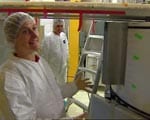Scientists debate whether prosthetic legs give Pistorius an unfair advantage in the 400-meter race
Sports journalist David Epstein at Sports Illustrated has written a comprehensive piece on the long-running global controversy surrounding double-amputee South African sprinter Oscar Pistorius, the first amputee to compete in the Olympics.
The Aug. 2 article “Fair or foul? Experts split over whether Pistorius has advantage” quotes SMU’s Peter Weyand, an expert in human locomotion.
Controversy has swirled around Pistorius as the debate continues over the scientific advantage he enjoys as a result of his high-tech, carbon fiber artificial legs. Weyand helped lead a team of scientists who are experts in biomechanics and physiology in conducting experiments on Pistorius and the mechanics of his racing ability.
Weyand is widely quoted in the press for his expertise on human speed. He is an SMU associate professor of applied physiology and biomechanics in the Annette Caldwell Simmons School of Education & Human Development.
EXCERPT:
By David Epstein
Sports Illustrated
LONDON — Before he changed into his racing legs, South African double-amputee sprinter Oscar Pistorius made sure to greet each and every photographer who showed up to shoot his training session last Sunday at St. Mary’s University College in Twickenham, far in the south of London. At the very same time that one of his PR reps was insisting that he wouldn’t be talking at all today, Pistorius was busily talking to everyone he could see. He greeted every onlooker with a handshake, going back when he missed one person. “I think I forgot to greet you,” he said softly, and extended his hand. The display prompted a British photographer to remark: “I’ve never come across that. He doesn’t need any PR, does he?” And it’s all the more remarkable considering that such manners flowed from a man who is an A-list celebrity in South Africa. Pistorius has owned white tigers and racehorses, and the gossip pages recently reported that he’s dating a Russian supermodel. (Two days ago, a zealous fan showed him a photo of “Pistorius 2012” tattooed on her arm.)That Pistorius is charismatic is beyond questioning. Nor is there any doubt of the magnitude of the inspiration he engenders. Pistorius’s Twitter picture is a shot of him — in his crescent, carbon-fiber Cheetah Flex-Feet — leaning down and jogging beside a little blonde girl whose own Cheetah legs are protruding, adorably, from beneath her tiny yellow sun dress. Or how about this scene, which sounds like the Paralympic variation of a bad barroom joke: guy with no lower arms or legs walks up to a guy born with no fibulas and starts asking about sprinting. But that actually happened, last year, the day before Pistorius ran in a Diamond League meet in New York City. Pistorius was gracious and patient in giving advice to the man, Andre Lampkin, a 23-year-old former football player who had recently lost parts of all four limbs to bacterial meningitis, and was still extremely wobbly on his new Cheetahs.
When the “Blade Runner” steps onto the track Saturday, it will be as South Africa’s top quarter-miler of 2012 and the first double-amputee (and first male Paralympian of any sort) to compete in the Olympics. And even though Pistorius — who had both lower legs amputated before he was a year old — is a veritable fount of inspiration, questions about his carbon fiber racing legs have followed him to London. Just before the Games began, Michael Johnson — Pistorius’s friend and the 400-meter world record holder — said that Pistorius should not be competing against able-bodied runners.
“My position is that because we don’t know for sure whether he gets an advantage from the prosthetics that he wears, it is unfair to the able-bodied competitors,” Johnson said. “That is hard for a lot of people to take and to understand when you are talking about an athlete and an individual who has a disability.” [ … ]
[ … ] Pistorius appealed the ban to the Court of Arbitration for Sport (CAS). He went for more testing, this time in a lab at Rice University run by physiologist Peter Weyand. The data from that testing found that Pistorius fatigued at a normal rate. Not to mention that energy efficiency has about as much to do with sprint performance as fuel efficiency does with drag-racing performance. University of Colorado physiologist Rodger Kram and Hugh Herr, a professor at MIT and world-renowned designer of prosthetics — both members of the scientific team that did the second analysis of Pistorius — presented the data to the CAS.
Herr, whose own designs have been commercialized by Össur, the company that makes the Cheetah Flex-Feet, has been Pistorius’s most vigorous supporter. And his life narrative bears an uncanny resemblance to that of Pistorius. Herr was a mountain-climbing prodigy, known as the “Boy Wonder,” until he suffered frostbite on a climbing trip as a 17-year-old in 1982 and lost both lower legs. Rather than accept the end of his climbing career, Herr immediately began designing climbing-specific prostheses that could change length mid-ascent and find purchase on nooks too small for human feet. And, almost as quickly, some of Herr’s competitors who saw a potentially unfair advantage called for him to be disqualified from competitive climbing. [ … ]
SMU is a nationally ranked private university in Dallas founded 100 years ago. Today, SMU enrolls nearly 11,000 students who benefit from the academic opportunities and international reach of seven degree-granting schools. For more information see www.smu.edu.
SMU has an uplink facility located on campus for live TV, radio, or online interviews. To speak with an SMU expert or book an SMU guest in the studio, call SMU News & Communications at 214-768-7650.



 Human diabetes has new research tool: Overfed fruit flies that develop insulin resistance
Human diabetes has new research tool: Overfed fruit flies that develop insulin resistance Observed! SMU’s LHC physicists confirm Higgs ‘God particle’
Observed! SMU’s LHC physicists confirm Higgs ‘God particle’ DOE Award: advancing SMU’s link to the God particle
DOE Award: advancing SMU’s link to the God particle Ancient tree-ring records from southwest U.S. suggest today’s megafires are truly unusual
Ancient tree-ring records from southwest U.S. suggest today’s megafires are truly unusual Modeling the human protein in search of cancer treatment: SMU Researcher Q&A
Modeling the human protein in search of cancer treatment: SMU Researcher Q&A Middle school boys who are reluctant readers value reading more after using e-readers
Middle school boys who are reluctant readers value reading more after using e-readers Dark matter search may turn up evidence of WIMPS: SMU Researcher Q&A
Dark matter search may turn up evidence of WIMPS: SMU Researcher Q&A